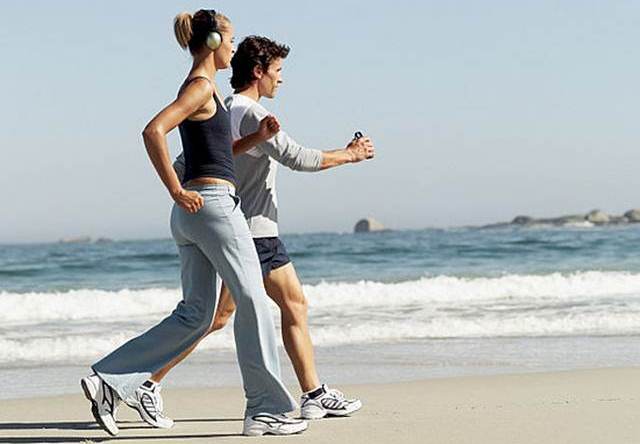The Walking-Off-Weight Breakthrough
Walking is often pigeonholed as a low-to moderate-intensity workout. And for good reason: Even those who make a real effort rarely get their internal speedometer above 4 mph. But that doesn't have to be the case. If you can improve your game by only a few tenths of a mile, walking can become an intense calorie-torching exercise. According to a 2006 study in the British Journal of Sports Medicine, walkers in their fifties burn 32 percent more calories when they adjust their speed from 4.1 to 4.6 mph compared with only a 25 percent boost from 3.6 to 4.1 mph.
The crucial dividing line is 4 mph. moving from 4 to 4.2 mph increases calorie expenditure more than changing from 3.8 to 4 miles, and going from 4.2 to 4.4 burns even more calories for the increment. Anything you get above 4 mph is going to be a big win, and it's a bigger win for each additional tenth you can add.
But are you capable of walking 4.5, 5 or even 6 mph? Absolutely, and you don't have to be especially fit to do it. However, changing your pace does require effort on your part. To improve your odds of success, follow these special three-step program:
STEPS 1 WALK THIS WAY
By changing your form slightly, you can move quickly in an efficient manner that feels more comfortable than simply doing what you normally do, only faster.
» MAINTAIN AN UPRIGHT POSTURE
Gently contract your abdominal muscles to keep your pelvis neutral and your lower back from arching excessively. And keep your eyes on the horizon: By looking forward, you bring your chin level with the ground, which helps keep your shoulders back and your chest open. This form facilitates fuller breathing and helps prevent unnecessary stress on your upper body.
» SWING YOUR ARMS FASTER
Bend your elbows 90 degrees, holding your arms in at your sides (don't swing them across your body or wing them out to the sides). Your legs will automatically keep up with your arms because your nervous system synchronizes your limbs. This synchronization keeps you balanced, upright and moving forward.
» POWER YOUR WALK FROM THE BACK LEG
When you walk faster than your usual pace, the natural tendency is to take longer steps with the forward-moving leg. The problem is that the farther you reach with your front foot, the more it acts like a brake and slows you down. So you may be moving faster, but you are doing so very inefficiently.
What's better: Increase the length of your stride on the back end by making a conscious effort to roll through the ball of your foot and push off your toes, which adds power to your walk. This will extend your stride behind you by keeping your trailing leg on the ground a microsecond longer. The result is shorter but stronger and faster steps.
STEP 2 PRACTICE
To get you up to speed, pick up your pace at a doable rate: Your one-mile time gets 15 seconds faster each week. Starts you walking four days a week for a total of 180 minutes, with two sessions devoted to brisk walks and two to interval training. Interval training, which involves alternating between strenuous exertion and more moderate effort, is key because the short bursts of fast walking condition your muscles for faster speeds. You also start to train your legs to move more quickly. To do this type of exercise, walk as fast as you can for 15 to 60 seconds, then recover by walking at an easy pace for the same amount of time. Repeat that cycle for the duration of your workout. In the last two weeks, one of these interval sessions will be done on inclines. Climbing hills gets your heart rate up and builds leg strength, both of which translate into greater speed on the flats.
STEP 3 GET STRONGER
You will see results more quickly—and protect yourself from injury—if you strengthen and stretch key muscles while you're increasing your speed. (See The Walker's Workout, for exercises.) The areas include:
» QUADRICEPS (FRONT OF THE THIGHS)
This group of muscles is an important source of power when you walk. Women at an average age of 61 were able to walk up to 15 percent faster after strengthening their quads for four weeks. That's enough to move most brisk walkers into the supercharged calorie-burning zone.
» CORE AND BUTT MUSCLES
These muscle groups also power your stride, but if they are out of shape, they can contribute to injuries. For example, weak gluteus medius muscles in your hip area—a common problem in females— allow your pelvis to tilt down, instead of remaining level, as your leg swings. This can create misalignment from your hips to your feet and can lead to knee injuries.
» HIP FLEXORS (TOPS OF YOUR THIGHS)
When these muscles are tight, they limit your range of motion and prevent you from fully extending your leg behind you for a powerful push off. In addition to the exercise on The Walker's Workout, yoga and Pilates are good workouts for targeting these muscles.
» SHINS
The tiny muscles here are responsible for keeping your feet from hitting the ground hard when you land. However, they're often weak from underuse and tend to burn out quickly, making them a major source of pain for walkers. Before and after every walk, do the series of stretching exercises on The Walker's Workout. If your shins start to scream during a workout, stop and do the series five or six times to ease the pain.



Comments
Post a Comment